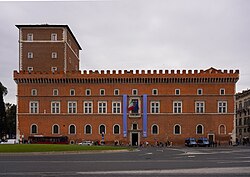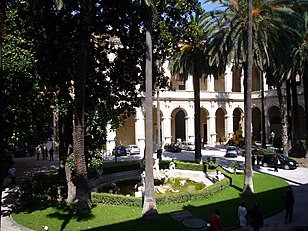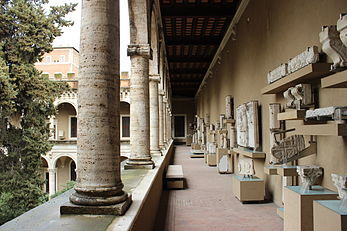Palazzo Venezia
| Palazzo Venezia | |
|---|---|
 Palazzo Venezia, main front (east front) facing the Piazza Venezia | |
 Click on the map to see marker | |
| General information | |
| Location | north of the Capitoline Hill, Rome, Italy |
| Coordinates | 41°53′46″N 12°28′53″E / 41.8962°N 12.4815°E |
The Palazzo Venezia or Palazzo Barbo (Italian:
The original structure of this great architectural complex consisted of a modest medieval house intended as the residence of the cardinals appointed as the titular holders of the Basilica of Saint Mark. In 1469, having undergone a massive extension, it became a papal residence and in 1564
History
Pope Paul II (Pietro Barbo)

It was rebuilt in 1451 when owned by Cardinal Pietro Barbo (1417-1471) who from 1464 ruled as
Palazzetto
Between 1466-9
Biscia Tower
The large square tower above the south end of the main block was built circa 1470, and encloses a more modest mediaeval predecessor. It is known as the Torre della Biscia ("Biscia Tower" ("Snake Tower")) possibly after the form of an ancient piece of sculpture enclosed within the masonry, or as the Torre di Carlo Muto (Tower of Carlo Muto), after the owner of the land purchased by Pietro Barbo.[6]
Pope Paul III (Alessandro Farnese)

Pope Paul III (Alessandro Farnese) (1468-1549, ruled as pope 1534-1549) made substantial use of Palazzo San Marco as a papal residence. In 1536 he invited Holy Roman Emperor and titular King of Italy[7] Charles V (during his triumphal return from the Conquest of Tunis) to the Palazzo San Marco for discussions concerning holding an ecumenical council of the Church, in order to formulate a response to the heresies of the Protestants, which eventually resulted in the Council of Trent in 1545. “The pope received Charles V with all honours”[8] and the meeting concluded successfully and "resulted in the publication of a papal bull calling all patriarchs, archbishops, bishops, and abbots to assemble at Mantua on 23 May, 1537, for a general council".[9] To welcome the Emperor a triumphal arch was built at the north-east corner of the Palazzo, to the design of Antonio da Sangallo the Younger (1484-1546).[10]
Paul III built a “mighty defensive tower, known as the Tower of Paul III” on the Campidoglio (Capitoline Hill) “an imposing construction through which (he) could literally oversee the whole of the City”[11] (demolished 1886). In order to reach this securely and privately he built a viaduct (known as the Arch of St. Mark, or Passetto) from the tower to the top floor of the south-east corner of the Palazzetto, “replicating the palace-passageway-fortress system” which links the Vatican and Castel Sant’Angelo.[12] Subsequently he reconstructed the Campidoglio (Capital) itself, which had become “a ramshackle collection of faded buildings and a place of executions”,[13] to the design of Michelangelo.
Pope Pius IV
In 1564 Pope Pius IV gave use of much of the building to the Republic of Venice for its embassy, but with use reserved for the titular cardinal of S. Marco, by tradition always a Venetian. The donation was received by Giacomo Soranzo (1518-1599), ambassador of the Republic of Venice, and the scene is recreated in an 18th century fresco on the western wall of the Sala del Pappagallo, showing Soranzo dressed in a black robe kneeling before the enthroned pope and receiving from him a document on parchment, with a depiction of the Palzzo Venezia in the background.[14]
Later History


Following the
During the fascist period,
On the advice of Achille Starace, Mussolini as a rule left the lights on in his office over night in order to cultivate an image of a workaholic totally dedicated to official business—"a man who never sleeps" as repeated by the propaganda.
It was at the Palazzo Venezia, in the Stanza del Pappagallo (Hall of the Parrot) where the fascist regime came to an end: a palace coup setting forth Count Grandi's Order of the Day demanding Mussolini's powers be taken away by the king. The vote by the Grand Council of Fascism left Mussolini in the minority, which enabled the king to dismiss and arrest him.
Present
The
In 1910, due to the erection of the Victor Emmanuel II Monument, the Italian Government enlarged the Piazza Venezia and built a replica of the Palazzo Venezia in yellow brick on the opposite side of the square. This building hosts now the offices of the Assiscurazioni Generali di Venezia. Also because of that the Palazzetto di Venezia, which closed the south side of the Piazza, was dismantled and rebuilt southwest of the Palazzo.
In late 2010 Mussolini's unfinished "most secret" bunker was discovered beneath the building.[15]
-
Palazzo Venezia cortile grande
-
Palazzo Venezia Roma
-
Palazzo Venezia loggia
-
Bust of Isis or 'Madama Lucrezia'
References
- ISBN 9781853114977.
- ^ "Appartamento Cibo refers to the seven rooms located in the northern wing of the palace, immediately after the Sala Regia, in some cases overlooking the internal garden, in others overlooking the ancient Via Papale, today's Via del Plebiscito; built as his residence by Cardinal Lorenzo Mari Cibo (c.1450-1504), titular holder of the Basilica of San Marco between 1491 and 1503 " [1] "The Sala Regia was still under construction at the time of Cardinal Marco Barbo (1420-1491), the room was finished under Cardinal Lorenzo Mari Cibo (c. 1450-1504)" (VIVE Vittoriano e Palazzo Venezia [2])
- ^ Touring Club Italiano, Roma e dintorni (Milan, 1965:91-97.
- ^ The so-called ‘Palazzetto’ in the Palazzo di Venezia Complex: A small construction history among the huge transformation events of the Rome centre in the early twentieth century Caterina F. Carocci, Renata Finocchiaro and Valentina Macca, University of Catania, Italy, post 2019, p.157 [3]
- ^ Carocci, Finocchiaro, Macca, p.158
- ^ VIVE, Facciata principale e atrio [4]
- ^ In 1530 Charles had been crowned by Pope Clement VII as Holy Roman Emperor and King of Italy
- ^ VIVE [5]
- ^ Catholic Encyclopedia, Council of Trent [6]
- ^ VIVE [7]
- ^ Antonella De Michelis, ‘’Villeggiatura in the Urban Context of Renaissance Rome: Paul III Farnese's Villa-Tower on the Campidoglio’’, published in Ballantyne, Andrew , ‘’Rural and urban : architecture between two cultures’’, 2009, pp.28-41 [8]
- ^ VIVE,L’opera di Paolo III Farnese [9]
- ^ De Michelis
- ^ vive.cultura.gov.it/en/palazzo-venezia [10]
- ^ Italian Dictator Mussolini’s Secret Bunker Unearthed
Sources
- Carlo, Cresti; Claudio Rendina; Massimo Listri (1998). Palazzi of Rome. Könemann. pp. 58–65.
External links
- Satellite photo The Palazzo Venezia is to the left of the Piazza Venezia's boat-shaped central lawns. The Palazzo's tower is exactly to the left of the "split" in the "boat". At the bottom is the white marble monument to Vittorio Emanuele.





